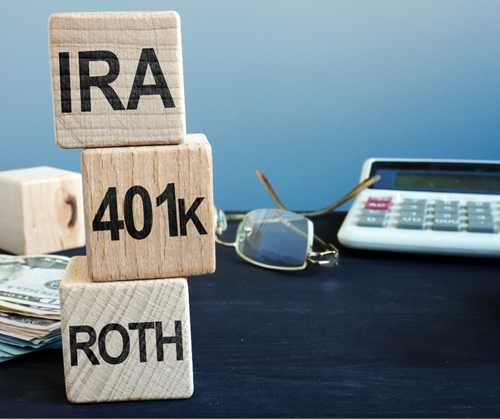
Retirement planning is the process of setting income goals, followed by the actions and decisions necessary to achieve those goals. This includes classifying sources of income, sizing up expenses, implementing a savings program, and managing assets and risk. Retirement planning is the financial strategy you take in saving, investing, and ultimately distributing money meant to sustain oneself during retirement. Planning prepares individuals for life after their income ends.
Depending on where you are in your life, whether you’re a recent college graduate or five years into your career, your retirement plan will constantly change. If you’ve just entered the workforce, your main goal will be to save a certain percentage of your income. Once you reach the median portion of your career, you may want to consider increasing your specific income or target goals and take steps to achieve them.
As a small business owner, you may have never thought about offering retirement plans to your employees. If nothing else, consider it as a recruiting tool – employees are concerned about their future and are looking for employers to provide peace of mind. The purpose of offering retirement benefits is to increase the economic security of your employees. Offering one has numerous benefits:
- Attract and retain quality employees
- Lower income taxes
- Supersize retirement returns
- Payroll deductions
- Long-term compounding
- Creditor protection
- Pre-tax contributions
- Employer contributions
- Roth contributions
If you are wondering if you should begin offering this type of benefit to your employees, you first want to explore the different options available. Continue reading to see which option(s) might be the best fit for your business.
Retirement Plan Options
Traditional IRA
A traditional IRA is available to anyone offering a wide range of plans and investment options. IRA stands for individual retirement account - meaning, they are tax-favored savings plans that are, for the most part, opened and managed by individuals themselves. Any individual who has taxable income can contribute to a traditional IRA.
When making contributions to a traditional IRA, it reduces your taxable income while the money grows tax-free until you withdraw it. It is very similar to a 401(k) plan; however, the contribution limits are much lower in a traditional IRA. As of 2022, the contribution limits are $6,000 if you are under the age of 50 or $7,000 if you’re 50 or older. Individuals do not pay income taxes on their contributions, but instead, you pay taxes when you withdraw the money from your account at a specified time.
Roth IRA
The main differentiator between a traditional IRA and a Roth IRA is when you receive the tax benefits. For a Roth IRA, you pay taxes on the money you contribute. This means that when you withdraw your money, you withdraw it tax-free at the time of retirement.
To decide which plan to go with, the traditional or Roth IRA, experts have said to determine whether you expect to be taxed at a higher or lower rate when you retire. Many individuals create their retirement plans assuming that they’ll fall into a lower tax bracket once they retire. If you feel that you won’t be in a lower tax bracket when you retire, you could pay less income tax with a Roth IRA.
When contributing to a Roth IRA, you are allowed to withdraw money after the age of 59 ½. However, there are several exceptions to the early withdrawal penalty. Should you purchase your first home, have an extensive amount of college expenses, or have a child, you might be able to withdraw from your Roth IRA with no penalty. With that being said, you are only able to contribute to a Roth IRA if your annual income is below a specific threshold.
SEP IRA
A SEP IRA stands for a simplified employee pension. This type of retirement plan is used mainly by self-employed individuals or small business owners. If you’re a business owner, this plan may be cheaper and easier to operate as opposed to a 401(k) plan.
With a SEP IRA, you have the capability to put away a greater amount of savings each year. An employer can contribute up to 25% of each employee’s income, up to a maximum amount of $61,000, as of 2022. If you’re self-employed, you’re able to contribute up to 25% of your net income up to $61,000. With a SEP IRA, individuals are 100% vested in employer contributions. However, the immediate vesting of employee benefits may be a disadvantage for employers since the employee will take the money with them when they leave.
Simple IRA
A simple IRA is a retirement plan option for small businesses with 100 employees or less. Simple stands for savings incentive match plan for employees - meaning, employers must do one of two things:
- Match employee contributions up to 3% of the employee's salary
- Contribute 2% of an employee's salary regardless of any contribution from the employee
Simple IRA plans offer a substantial source of income at the time of retirement by allowing employers and their employees to set aside money within retirement accounts. The main differentiator between conventional retirement plans is that with a simple IRA, there are no start-up and operating costs.
With this type of retirement plan, employees are always fully vested which means no matter when the employee leaves the company, they can keep all the employer’s contributions. In 2022, employees can contribute a maximum amount of $14,000 of their annual salary or if they’re over the age of 50, they can contribute up to $17,000.

401(k)
The most popular option for a retirement plan is a 401(k). According to the Internal Revenue Service (IRS), a 401(k) is a feature of a qualified profit-sharing plan that allows employees to contribute a portion of their wages to individual accounts. The plan can be a profit-sharing, stock bonus, pre-ERISA money purchase pension, or a rural cooperative plan.
An employee who signs up for a 401(k) agrees to have a portion of each paycheck paid directly into an investment account. Some employers may decide to match part or even all the employee’s contributions. There are two basic types of 401(k) plans – Traditional and Roth.
The money in your 401(k) grows tax-free until you withdraw it. Once you choose to withdraw it, you’ll pay income tax on the money you take out. However, you must be 59 ½ or older to withdraw your money from the 401(k) plan without a penalty. You are also required to start withdrawing money from your plan at the age of 72.
Most employers tend to offer 401(k) plans because they have fairly high contribution limits. In 2022, you can contribute up to $20,500 or $27,000 if you’re over the age of 50.
Tom Smith, Director of Retirement Services at GMS, stated, “For employees, a 401(k) holds numerous benefits. Contributions are deducted directly out of their paycheck versus the employee having to send money to an account themselves. If their employer matches contributions, then it becomes a no-brainer for the employee to participate because they leave free money on the table if they do not.”
Solo 401(k)
A Solo 401(k) assists in maximizing retirement savings for individuals who are self-employed and business owners that don’t have employees. These plans are also known as individual or one-participant 401(k) plans. A Solo 401(k) is very similar to a standard 401(k) plan, except for the ability to boost your savings by contributing as both the employer and employee.
Individuals can contribute up to 100% of self-employment income with a maximum amount of $20,500 or $27,000 if you’re over the age of 50. In addition, you can act as the employer since you’re self-insured and contribute up to 25% of your business’ income. This may be the best option for those who are self-insured as you may be able to contribute more with this dual contribution formula.
Partner With GMS Today
No matter which retirement plan you choose, they all provide tax advantages as incentives to save for retirement. Now, you may still have a handful of questions and are still hesitant if you should offer a retirement plan to your employees. GMS is here to help. A PEO like GMS can leverage group buying power to reduce plan costs for small businesses and take on the fiduciary burden to ensure you remain compliant. As a business owner, you can stop wasting time trying to make sense of your legal responsibilities when you partner with GMS. With GMS, you easily establish:
- 401(k) eligibility requirements
- Vesting schedules
- Tax-deductible matching
- Profit-sharing contributions
For more information about offering retirement plans to your employees, contact our experts today.